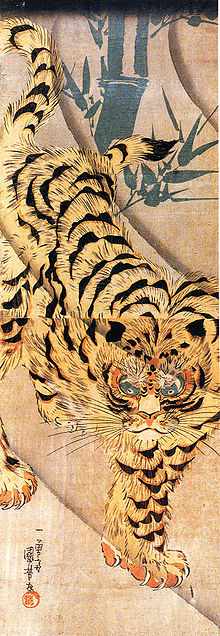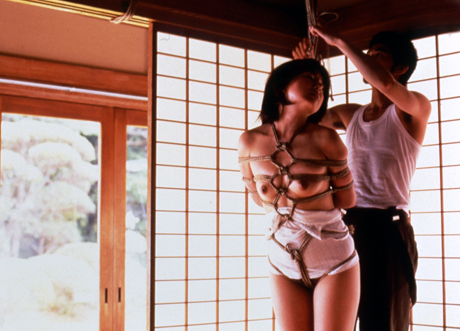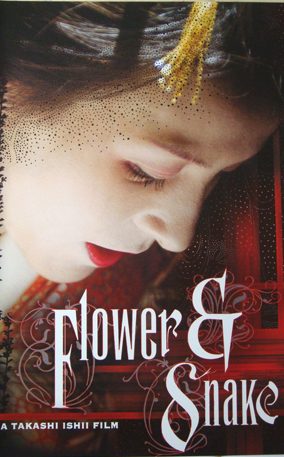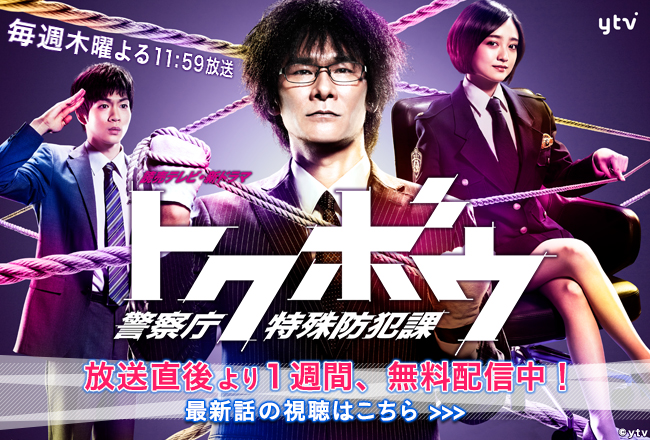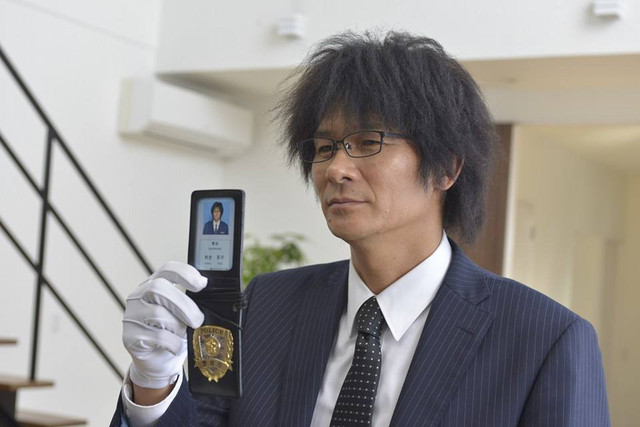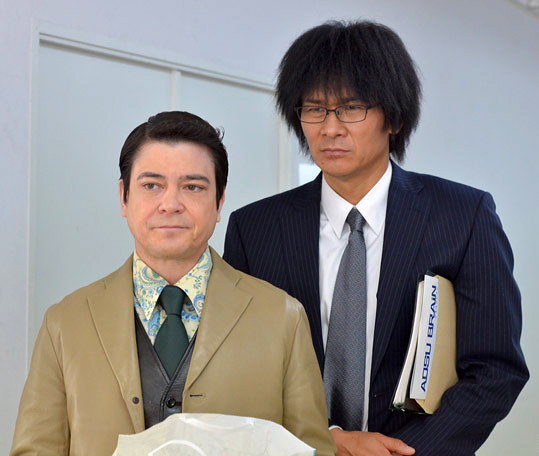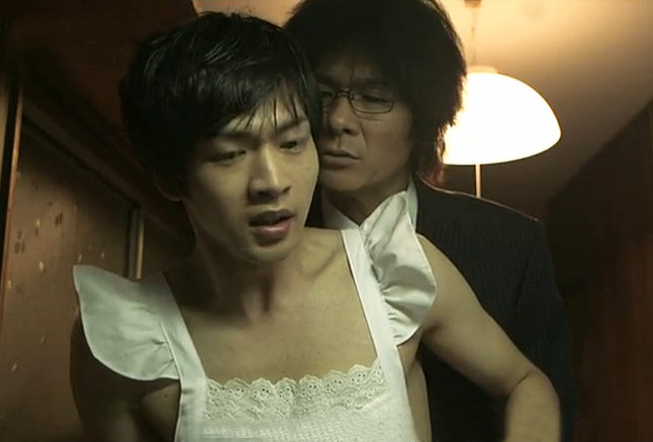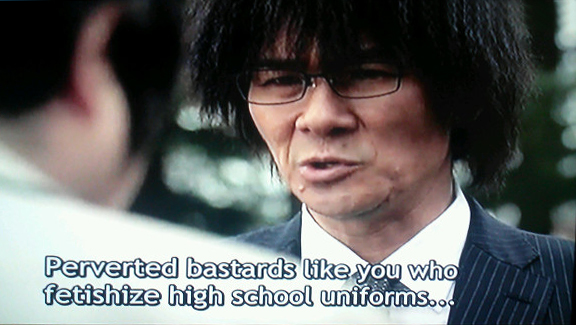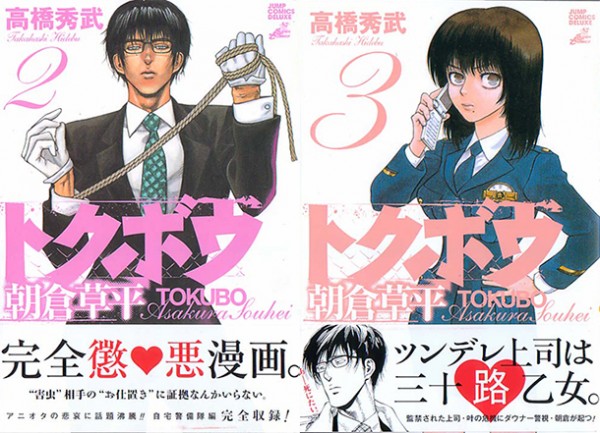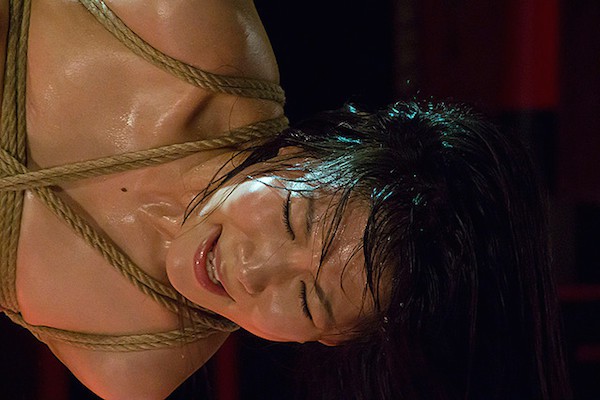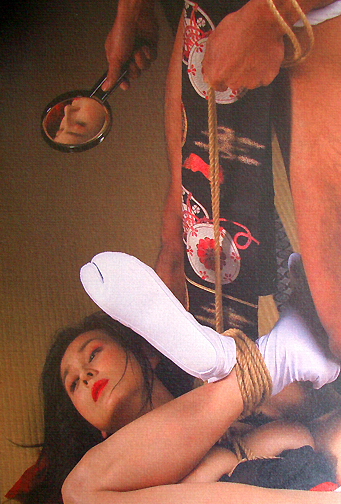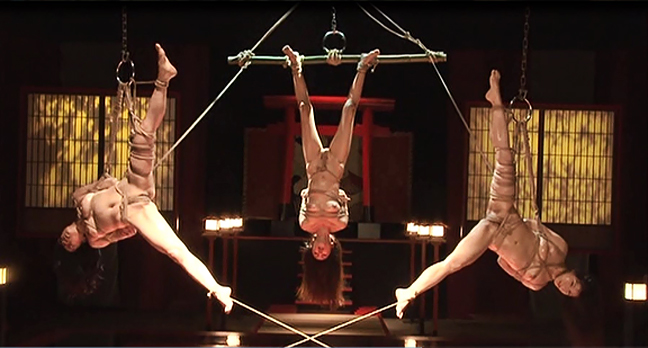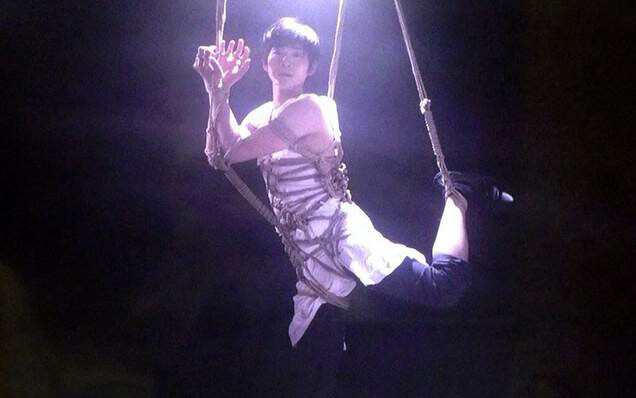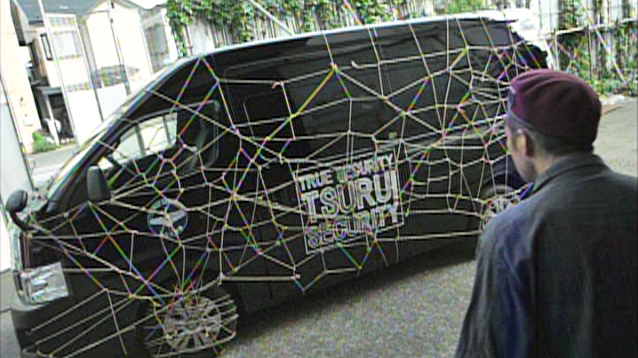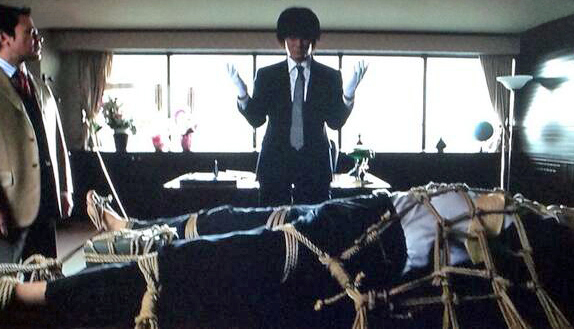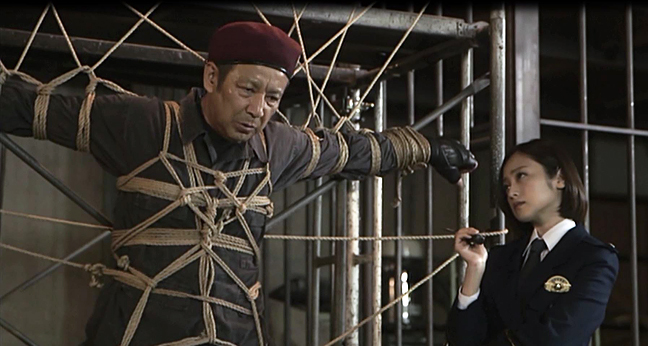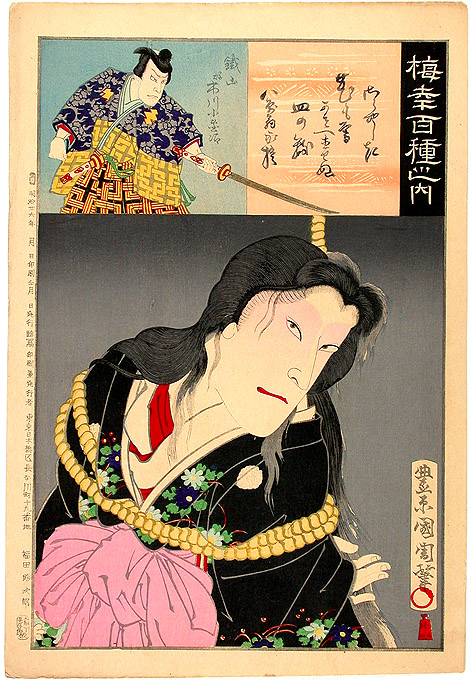Or everything you always wanted to know about Japanese erotic bondage when you suddenly realized that you didn't speak Japanese
The Beauty of Kinbaku
Kinbaku
and Art
Please note: no part of these articles may be reproduced by any means without the express written consent of the author or the publisher, King Cat Ink.
Chapter Six
Kinbaku and Art-Rigging for Movies and TV
by Master "K"
One of the more fascinating uses of Kinbaku is when it's employed for dramatic purposes in mainstream music videos, motion pictures and television shows. I use the term "mainstream" here to differentiate between entertainments intended for a general audience (i.e. commercially available music downloads, wide release films and network TV shows) and Japanese style rope bondage used in the more minority world of pornography.
In Japan, there is a long history of this "mainstream" usage. Kabuki theater plots abound in scenes involving one character or another being arrested, bound and punished and this tradition is probably the grand daddy for all that came later in film and video. Of course, there is a difference. In theater the tying had/has to be easily repeatable from performance to performance and, therefore, simple and safe to do and also visible to the last customer in the last row of the theater, whereas in more modern media the "bondage" usually has to look very real up close and this often involves a genuine risk in the doing of it.
This page is best viewed on Google Chrome.
When you add to this the tremendous cost of these filmed productions and the fact that the people being tied are not, usually, BDSM fans but working actors and entertainers whose injury during the filming of a dangerous scene could cause productions to come to a screeching halt with devastating economic consequences, it's easy to see that the "rigger" of these rope "stunts" needs an extremely high degree of experience and skill. This is especially true when Kinbaku is the style of rope employed since its very complexity of design makes it a far trickier bondage to do than, say, the old Western movie cliche of tying a damsel in distress to the train tracks!
As with movies in the West, films in Japan employed bondage scenes as occasional parts of their narratives almost since the first "flickers" arrived with the Thomas Edison kinetoscope in Tokyo back in 1896. However, it was in the late 1960's and 1970's that more sophisticated Kinbaku began to be seen on Japanese screens. This occurred at just about the same time that the term BDSM (bondage, discipline and sadomasochism) "came out of the closet" and began to be more generally known and better understood by the Japanese public through magazines, TV broadcasts and films.
Cover of the DVD re-issue of the original 1974 version of "Flower and Snake."
Many of the most skilled rope masters of that era and beyond have "rigged" for films. For instance, Tsujimura Takashi did the work on several general audience films for the mainstream studio Toei in the late 1960's. In the 1990's the legendary bakushi Nureki Chimuo did the same work on the low budget film "Nawa Deka" ("Rope Detective") and Yukimura Haruki did the rope for the splendid and very funny "I am an SM Writer," based on the novella by Oniroku Dan, in 2000.
Still from "I am an SM Writer" (2000) - Kinbaku by Yukimura Haruki.
However, the king of serious Japanese Kinbaku riggers for film has to be the great Urato Hiroshi who, working with such legends as the aforementioned Oniroku Dan and super star actress Naomi Tani, did the tying for over 50 of the well known SM themed films that were produced by Nikkatsu Studios (founded in 1912) to help shore up their flagging theatrical business in the 1970's
Portrait of the legendary Nikkatsu movie "rigger" Urato Hiroshi.
Since I cover all of the above mentioned stars, rope masters and films in detail in "The Beauty of Kinbaku," I'll leave history for now and move on to more currant events.
Today, the laurel of most active "rigger" for mainstream Japanese entertainment has to be awarded to the well known bakushi Arisue Go. To those that know him this achievement comes as no surprise since, like Urato Hiroshi before him, Arisue is a very intelligent, literate bakushi (rope master) whose writings on Kinbaku (including a well received book of short stories) easily demonstrates the sensitivity, thoughtfulness and skill needed to work well with other artists in high pressure, big budget film collaborations.
Arisue Go.
Although by no means elderly, Arisue Go has been in the SM business a long time and actually did his first work for film in the 1980's. However, it was in 2004 that his rigger's star really began to rise when he did the Kinbaku for the very successful mainstream release "Flower and Snake," a remake of the famous 1974 original from Nikkatsu that starred Naomi Tani and was based on Oniroku Dan's legendary novel. Since then he's handled the rope for several more versions of this title including the most recent, "Flower and Snake - Zero."
Poster for the 2004 "Flower and Snake" re-make starring Aya Sugimoto.
Of equal interest is his latest credit for the fascinating and delightful television series "Tokubou."
Perhaps due to the influence of the (imho) overrated 2003 comedy "Lost in Translation" starring Bill Murray, Western impressions of Japanese TV as incomprehensible, zany and completely alien to our tastes have become something of a critical cliche. And, as is the case with many cliches, such pat assumptions are often wrong. In my time in Japan I've seen quite a few TV dramas, comedies, documentaries and variety shows that rival the best we in the West produce and this is certainly true of the series "Tokubou;" plus it's a lot about rope!
TV advertising art for the Yomiuri Telecasting/Nippon Television series "Tokubou."
"Tokubou" is a 1 hour, 13 episode 2014 co-production of Yomiuri Telecasting in Osaka and Nippon Television in Tokyo and was intended as "late night" programming for viewers, broadcasting at midnight on Thursdays from early Spring through mid-Summer.
It can best be described as a dramatic police procedural with a great deal of wit. It's the story of Asakura Sohei (played by the fine actor Tsuyoshi Ihara) an inspector in the elite "Moral Influence National Police Agency Special Crime Prevention Section" (or "Tokubou" for short) whose job it is to investigate crimes and criminals that are difficult to prosecute and even trickier to get standard convictions for.
Tsuyoshi Ihara as Inspector Asakura Sohei badges a suspect in "Tokubou."
With the help of a young assistant named Tsuji and under the command of his tiny, sexy and amusingly sadistic female section chief Kanou, he investigates such crimes and criminals as: food mis-labelling that causes death in supposedly ritzy restaurants, businesses that cruelly exploit their employees, high school girl "paid dating" rings, corrupt real estate attorneys and right wing "security companies" intent on taking over the government. The gimmick here is that, since these criminals can't easily be prosecuted, Asukura is both investigator and judge and when he finds the guilty party he ALSO becomes the agent of punishment and, after opening his briefcase full of rope, administers "corrective enforcement" by tightly binding and then humiliating these malefactors and forcing them to admit and mend their evil ways.
Inspector Asakura Sohei (Tsuyoshi Ihara) and his sexy and sadistic boss Kanou (Yumi Adachi).
For those that know Japanese history this is an especially clever dramatic conceit since this type of rope binding and rope punishment is EXACTLY the way criminals were handled in the samurai world of Edo era Japan (1603 to 1867). To see this history updated to our modern times is very amusing.
In fact, in my opinion, everything about this series is well done, from the clever writing and acting (as mentioned, the wonderful Tsuyoshi Ihara plays Asukura, young and talented singer/actor Kohei Matsushita plays the assistant, the gorgeous Yumi Adachi plays the sexy section chief and the hilarious Jay Kabira plays a fellow detective and rival of Asukura's -- all are superb), to the fine direction, stunts and, most certainly, the ingenious Kinbaku (by Arisue Go).
Inspector Asakura Sohei (Tsuyoshi Ihara) with fellow detective and rival Tetsuto Date (Jay Kabira).
What is especially entertaining for those of us that enjoy the world of Kinbaku or even BDSM generally are the many sly, smart characterizations and situations the show creates. For instance, while detective Asakura is a "super dom" and a genius with rope on the street, in the office he's the complete sub to his tiny boss Kanou. And while his young assistant Tsuji idolizes Asakura on the job, he gets more than a little uncomfortable when the detective insists he go shirtless and wear only a frilly apron to cook Asakura's favorite meal, an omlette.
Inspector Asakura Sohei with his uncomfortable, apron wearing, young assistant Tsuji (Kohei Matsushita) making omelettes.
A good example from "Tokubou's" dialogue of how it plays with Japanese fetish/BDSM conventions.
And then there's Asakura's telling catch phrase "Shinitai" which he wearily utters with eyes closed whenever the evil he encounters in society proves too much for his depressed spirits. On screen it's translated as "I want to die" or "I could just die" but the phrase actually comes from Sumo wrestling and describes a "falling, hopeless position from which it's impossible to recover." Amusing as it is, it's another example of how the show, on occasion, blends more serious philosophical matters with its comedy and drama to examine such modern obsessions as "success at any price," exploitation of others, societal venality, personal selfishness and the various other less pleasant aspects of our times.
Inspector Asakura Sohei (Tsuyoshi Ihara), depressed at the evils of the world, about to utter his signature phrase, "Shinitai."
As I said, a clever, witty, knowing show for all lovers of Kinbaku.
The program is based on an 8 volume series of manga books by female author/artist Takahashi Hidebu. Unfortunately, unlike many recent manga, they were never translated into English but the good news is that, as of this date (10/14), one can see the TV series "Tokubou" on US television with excellent English subtitles, either through Internet streaming video or on the Crunchy Roll channel on Roku!
Two covers from the original manga book series "Tokubou."
I certainly recommend this series to anyone interested in intelligent, entertaining TV drama, to say nothing of Kinbaku. In fact, I was so impressed by the show that I got in touch with Arisue Go in the hope of talking to him about his experiences working on it. Happily, he was gracious enough to agree to an exclusive interview about his "rigging" career, his involvement in the "Flower and Snake" film franchise and, most especially, his most recent success, "Tokubou."
Enjoy!
The Interview:
Master "K": You have become known as the most important "movie" rigger/bakushi in Japan today with many credits on famous films and TV shows. How did you start doing this?
Arisue Go: I got an offer from a film director, Jun-ichi Suzuki, to do Kinbaku scenes for his film “Akai nawa: hateru made" ("Until the Red Rope Runs Out"). That was the first time I did Kinbaku for film. The screenwriter for the movie was Takashi Ishii. Then, years later, I supervised the Kinbaku scenes in “Hana to Hebi" ("Flower and Snake") in 2004 which was directed by Takashi Ishii himself and starred Aya Sugimoto. Since then, I have been in charge of the Kinbaku scenes for all of the “Hana to Hebi” series including the most recent “Hana to Hebi - ZERO.” I also worked on Takashi Ishii’s “Amai Muchi ("Sweet Whips"). I think the offers from Takashi Ishii provided the strongest springboard for me to be exposed to more TV and film gigs.
Production still from "Flower and Snake - Zero" (2014).
K: As you just mentioned, you are especially known for the recent sequels to Oniroku Dan's famous "Flower and Snake." Did you work closely with the director to create the interesting Kinbaku for these films or did you design the ties yourself?
AG: Based on the film director’s script, I gave advice as a Kinbakushi (rope master) and created the pictures/scenes. Generally, directors already have images for the Kinbaku scenes that they want to make. When I realize their visions, I incorporate my images with the director’s images. Also, by taking safety aspects into consideration, I transform the director’s images into something realistic. Thus, it is a collaboration with the director, while the Kinbaku designs themselves are my originals.
K: How was it working with and tying the beautiful Aya Sugimoto (star of two of the recent films)?
AG: Kinbaku scenes with Aya Sugimoto were rather hard and tough. So, I was grateful that she could in fact endure them. It was as if the shooting itself was a seme (torture) for her. She is a person who has the physical strength and perseverance to endure the shooting. It was the first time for her to experience Kinbaku, but perhaps, her mind went through a sort of a change in the course of the filming. It seemed as if she discovered a new Eros (an erotic allure and/or sensual personality) in herself, and such Eros was what the public had actually wanted to see.
Aya Sugimoto in "Flower and Snake" (2004) - Kinbaku by Arisue Go.
My personal impression is that her body is so perfect that her Eros (charisma and sexuality) is clearly different from “Eros as obscenity” (sexual vulgarity). Rather, her Eros is “Eros as beauty.” That is probably why many women reacted so well to her performance. She is definitely one of the people who have left strong impressions on me.
K: The newest "Flower and Snake" film is "Flower and Snake - Zero (2014)" (starring the lovely Maiko Amano among others) which appears to be almost an action film. The Kinbaku that I've seen from the press releases and trailer is very dramatic and looks quite complex. Was there one scene or tie that was especially challenging for you?
AG: The most challenging scene was where I had to suspend three people at once. Even though their bodies were completely different, they all had to endure the tie at the same time. Therefore, I tried to understand everyone’s physical weakness and searched to create a tie that would not put too much load on their body. I had to work creatively through trial and error to complete the tie. The biggest key was probably the timing. I waited for the opportune moment, when the actresses got used to the rope, to do the tie. As you know, people’s endurance against rope changes over time.
Dramatic three character suspension from "Flower and Snake - Zero" (2014).
K: Your most recent credit is for the delightful TV show "Tokubou." This popular program is a police comedy/drama where each week's villain is punished by being bound in different and interesting ways. I have to say I was very impressed by the show and especially by your work because it's so different from your more dramatic movie rigging. Your rope is very creative and very funny! How did you get this job?
AG: One actor, who was in “Hana to Hebi - Zero,” also worked on TV dramas. Around when we were filming the movie, he came to know that a TV production company was developing a project for “Tokubou.” So, the actor introduced me to the TV production company.
Creative, amusing Kinbaku by Arisue Go in a dream sequence from "Tokubou."
K: How long did you get to do the Kinbaku for each week's episode of "Tokubou?"
AG: In average, it took 5 days to record an episode. In Japanese TV we shoot all day, from each morning at 6 or 7 AM to around midnight or 1 AM just before the last train (so the crew can travel to their homes). Shooting for the Kinbaku scenes took 1-2 days out of those 5 days.
K: Did you have assistants to help you?
AG: Yes, I had one assistant (Naoko Nagasawa.) The director created images for the ties based on the scenario. Then, I worked with my assistant to expand on the images and do the actual tying. Since we used more ropes than usual, it was very helpful to have the assistant. Staff members of the drama production also helped me as well.
A female character in rope by Arisue Go in "Tokubou."
K: I've read the manga books the show is based on and the Kinbaku illustrated in them is fairly sophisticated! Do you know if the author is a fan of Japanese tying? It also looks as if the ties in the show tried to duplicate some of the Kinbaku in the manga. Is this true?
AG: I don't know the author personally but I think that in order to create an interesting world in manga with a reference to Kinbaku one must somehow have an interest in Kinbaku.
As for your second question, the show did not at all try to duplicate the Kinbaku in the manga. However, the show is based on the basic premise and the world view of the manga, with a main character who attempts to correct the world by punishing bad people with rope. However, since the manga is set in a different time than the TV show, each TV episode was newly created by the TV production team to reflect current social concerns.
For example, there has recently been several cases of death caused by people using "dappou herbu" (illicit herbs --- herbal drugs that are not illegalized yet in Japan). Tokubou aired one episode with the theme of "dappou herbu" just a few weeks before the first of these cases hit the news!
Inspector Asakura Sohei is so expert in Kinbaku that he can even bind a truck!
K: Since you're tying a different actor each week on TV, how do you decide what type of tie to do and how do you approach each actor to make them feel comfortable and safe?
AG: First, we created images for Kinbaku based on the script. What the drama required was Kinbaku as an entertainment. Therefore, I added elements of entertainment to my original Kinbaku. For example, if the scenario said, “tie to a desk,” I looked for ways of creating a tie that would have a stronger dramatic or comic impact on the viewer. In general, I decided what kind of Kinbaku to administer based on the scenario, but when deciding on the actual shape of the tie, I also took into consideration the actor’s psychological and physical characteristics. However, since each actor had the mind and the body of a professional performer, they actually responded to every possible demand of the Kinbaku. In the end, I valued communication through conversations the most in order to make sure that the actors felt safe when receiving the ties. In any case, that’s what I value the most every time I tie.
Asakura Sohei prepares to administer "corrective enforcement" in "Tokubou."
K: Is there one episode of "Tokubou" where you're most pleased by the Kinbaku?
AG: The 13th episode, which was the last one in the season. There were many Kinbaku scenes in the episode, many of which were ties I had never done before. Suspending the soldier-type character with a red beret gave me the strongest sense of accomplishment. I created a tie that only such a tough guy could endure. I also used a lot of rope for this tie. I used 3 times more than the usual amount of rope.
Section chief Kanou gets her man in the final episode of "Tokubou" - Kinbaku by Arisue Go.
K: Will you ever appear on this show as you did in several of the films you've rigged for?
AG: No. I was only behind the scenes.
K: What would you say are the key differences in tying for movies and TV and tying privately (with a submissive) or tying for photographs?
AG: In private, I tie for my own satisfaction and as a service for specific individuals. In films and TV, I tie as a service to the mass audience. People often talk about S&M and say that S actually stands for “services” (as opposed to Sadist or Sadistic) and M for “manzoku" ("satisfaction" - as opposed to Masochist or Masochistic). This is what I'm always striving for.
K: Thank you so much for your most interesting comments and congratulations on your recent success with the delightful "Tokubou!"
Please join us next time as we continue our exploration into the fascinating subject of “Kinbaku in Art!”
Kabuki theater print showing a bound woman by Kunichika (1893).
Links to Other Chapters of Kinbaku and Art
